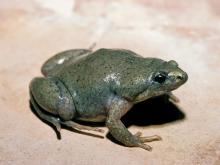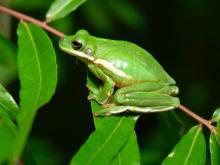Reptiles and Amphibians
Media

Species Types
Scientific Name
Lithobates sphenocephalus (formerly Rana sphenocephala)
Description
The southern leopard frog is an excellent jumper and quickly leaps into water when startled. From March through July, the males make chuckling or quacking calls from shallow water. Occurs statewide except for the northwestern corner.
Media

Species Types
Scientific Name
Lithobates blairi (formerly Rana blairi)
Description
A medium-sized spotted frog, the plains leopard frog lives in pastures, prairies, and marshes. The ridge of skin along each side of the back is broken, and a small hind section of it is shifted upward. It occurs nearly statewide, including the Bootheel, but is only rarely present in the Ozarks.
Media

Species Types
Scientific Name
Gastrophryne olivacea
Description
The western narrow-mouthed toad has a plump body, short legs, uniform color, small, pointed head, and a fold of skin across the back of the head. The general color is gray, tan, or olive tan. In our state is is reported from far western Missouri and east along the Missouri River as far as the center of the state.
Media

Species Types
Scientific Name
Hyla cinerea (syn. Dryophytes cinereus)
Description
The bright green treefrog hides perfectly among cattail leaves, where it rests until evening. Then it begins hunting for insects. In Missouri, it occurs mostly in the Bootheel.
See Also
About Reptiles and Amphibians in Missouri
Missouri’s herptiles comprise 43 amphibians and 75 reptiles. Amphibians, including salamanders, toads, and frogs, are vertebrate animals that spend at least part of their life cycle in water. They usually have moist skin, lack scales or claws, and are ectothermal (cold-blooded), so they do not produce their own body heat the way birds and mammals do. Reptiles, including turtles, lizards, and snakes, are also vertebrates, and most are ectothermal, but unlike amphibians, reptiles have dry skin with scales, the ones with legs have claws, and they do not have to live part of their lives in water.





















